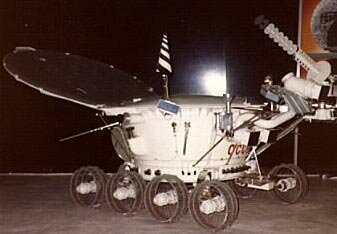

Оглавление РефератыThe Moon2.5) Lunokhod-11970 Lunokhod-1
The basic Ye-8 was deigned to soft land on the Moon and deliver an automatic, self-propelled lunar vehicle, Lunokhod, for purposes of surveying sites for later manned landings and lunar bases. It was also intended that the spacecraft would provide a radio homing beacon for precision landings of later manned spacecraft. The design had its origins in Korolev’s L2 project of 1963. This evolved within OKB-1 to the globular Ye-8 of 1965 before further development of unmanned planetary spacecraft was passed to the Lavochkin bureau. There the design was refined and modified for a single launch by a Proton launch vehicle. By the time the spacecraft flew, America had won the manned moon race and mission objectives were to collect images of the lunar surface, examine ambient light levels to determine the feasibility of astronomical observations from the Moon, perform laser ranging experiments from Earth, observe solar X-rays, measure local magnetic fields, and study mechanical properties of the lunar surface material. The lander had dual ramps by which the Lunokhod descended to the lunar surface. The lander and rover together weighed 1814 kg on the lunar surface. The Lunokhod itself consisted of a tub-like compartment with a large convex lid on eight wheels. It stood 135 cm high, 170 cm long and 160 cm wide, with a mass of 840 kg. The 8 wheels each had an independent suspension, motor and brake. The rover had two speeds, ~1 km/hr and ~2 km/hr. Lunokhod was equipped with four TV cameras, three of them panoramic cameras. The fourth was mounted high on the rover for navigation, and could return high resolution images at different rates (3.2, 5.7, 10.9 or 21.1 seconds per frame). These images were used by a five-man team of controllers on Earth who sent driving commands to the rover in real time. Communications were through a cone-shaped omni-antenna and a highly directional helical antenna. Power was supplied by a solar panel on the inside of a round hinged lid which covered the instrument bay. A Polonium-210 isotopic heat source was used to keep the rover warm during the lunar nights. Scientific instruments included a soil mechanics tester, solar X-ray experiment, an astrophotometer to measure visible and UV light levels, a magnetometer deployed in front of the rover on the end of a 2.5 m boom, a radiometer, a photodetector (Rubin-1) for laser detection experiments, and a French-supplied laser corner-reflector. Lunokhod was designed to operate through three lunar days (three earth months) but greatly exceeded this in operation. |
|
Конкурс рефератов: Тема: The Moon Автор : БАННЕРЫ: |

